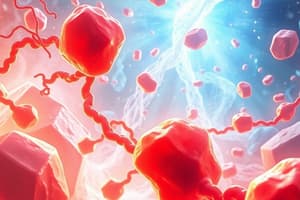Podcast
Questions and Answers
What is the purpose of the enzyme used in the cholesterol test?
What is the purpose of the enzyme used in the cholesterol test?
- To catalyze the reaction between hydrogen peroxide and 4-aminoantipyrine
- To convert cholesterol into cholestenone
- To measure the concentration of cholesterol in the sample
- To break down cholesterol esters into cholesterol and fatty acids (correct)
What is the wavelength used to measure the absorbance of the sample in the cholesterol test?
What is the wavelength used to measure the absorbance of the sample in the cholesterol test?
- 450 nm
- 500 nm (correct)
- 600 nm
- 550 nm
What is the purpose of the standard used in the cholesterol test?
What is the purpose of the standard used in the cholesterol test?
- To calibrate the spectrophotometer
- To provide a known concentration of cholesterol for comparison
- To ensure the accuracy of the test
- All of the above (correct)
What is the recommended temperature for incubating the samples in the cholesterol test?
What is the recommended temperature for incubating the samples in the cholesterol test?
How long should the samples be incubated in the cholesterol test?
How long should the samples be incubated in the cholesterol test?
What is the conversion factor used to convert cholesterol concentration from mg/dL to mmol/L?
What is the conversion factor used to convert cholesterol concentration from mg/dL to mmol/L?
What is the normal range for total cholesterol in adults?
What is the normal range for total cholesterol in adults?
What is the recommended storage condition for cholesterol samples?
What is the recommended storage condition for cholesterol samples?
What is the primary role of HDL cholesterol in the body?
What is the primary role of HDL cholesterol in the body?
What percentage of plasma cholesterol is esterified with fatty acids to form cholesterol esters?
What percentage of plasma cholesterol is esterified with fatty acids to form cholesterol esters?
Which type of cholesterol is referred to as 'bad cholesterol'?
Which type of cholesterol is referred to as 'bad cholesterol'?
What is the significance of determining serum cholesterol levels?
What is the significance of determining serum cholesterol levels?
Which of the following is NOT a risk factor for cardiovascular disease?
Which of the following is NOT a risk factor for cardiovascular disease?
Which of these is a source of cholesterol in the body?
Which of these is a source of cholesterol in the body?
Flashcards are hidden until you start studying
Study Notes
Cholesterol
- Cholesterol is essential for cell membranes, hormones, and bile acids formation
- It is obtained from both diet and liver production
- Cholesterol is carried in the blood attached to proteins, forming lipoproteins
Types of Cholesterol
- LDL cholesterol (bad cholesterol) is part of low-density lipoprotein
- HDL cholesterol (good cholesterol) is part of high-density lipoprotein, helps prevent disease by carrying cholesterol away from cells to the liver for breakdown and removal
Importance of Determining Serum Cholesterol
- Estimating risk of cardiovascular disease
- Diagnosis and classification of lipemia
- Requested for individuals with risk factors such as:
- Family history of high cholesterol or heart disease
- Being overweight or obese
- Diabetes mellitus
- High blood pressure (hypertension)
- Smoking cigarettes
Principle of the Method
- Enzymatic colorimetric method used to determine total serum cholesterol level
- Involves cholesterol esters, cholesterol, and fatty acids reaction
- Measured spectrophotometrically at λ=500 nm and compared to a standard of known cholesterol concentration (200 mg/dL)
Test Preparation
- No fasting required for a cholesterol test
- Sometimes a fasting sample is required for a full lipid profile including cholesterol
- Sample (serum or plasma) requirements:
- Stability of the sample for 7 days at 2-8ºC
- Freezing at –20ºC will keep samples stable for 3 months
Procedure
- Assay conditions:
- Wavelength: 505 nm (500-550)
- Cuvette: 1 cm light path
- Temperature: 37ºC /15-25ºC
- Reagents and sample preparation:
- Blank, standard, and sample added to cuvette
- Mix and incubate for 5 min at 37ºC or 10 min at room temperature
- Read absorbance (A) of samples and standard against the blank
Calculation
- Conversion factor: mg/dL x 0.0258= mmol/L
- Ranges for total cholesterol in adults:
- Normal: Less than 200 mg/dL
- Borderline high: 200 to 239 mg/dL
Studying That Suits You
Use AI to generate personalized quizzes and flashcards to suit your learning preferences.



